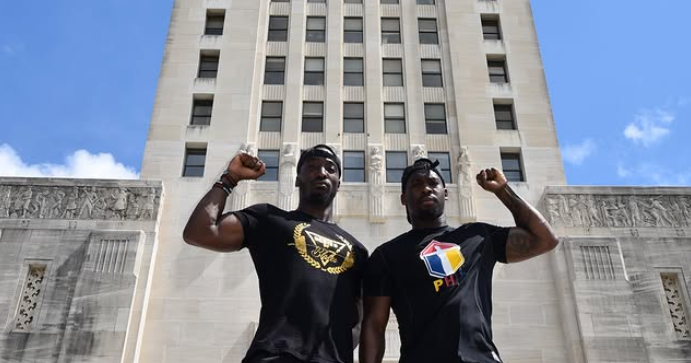Copyright Baton Rouge Advocate

Pushups, sprints and squats — staples of high-intensity interval training — aren’t typical conditions of probation terms. But for the past 12 weeks, they have been an integral part of an unlikely journey for three teenage boys, each charged with nonviolent gun offenses in Baton Rouge. For two hours every Saturday, the three met at Gus Young Park for intensive group therapy, mentorship discussions and, of course, sweat. “Our focus is on using physical fitness as a tool to bridge the gap in conversation and just getting the guys comfortable overall,” said Michael Blakes, a strength and conditioning coach at Glen Oaks Magnet High School and co-founder of Sweating N Spirit, a nonprofit that helps youngsters with physical fitness and career development. Blakes and his business partner, Dennis Jones, were recruited by the East Baton Rouge District Attorney’s Office and Juvenile Court to participate in the Chances Youth Intervention Program, a pilot initiative that aims to shift the mindset of young people who are teetering toward a life of crime and incarceration. “Their thought process, the 'why' behind their behavior, is being addressed,” said East Baton Rouge Juvenile Court Judge Gail Grover. Plenty of court intervention programs exist in Baton Rouge, said District Attorney Hillar Moore, but few, if any, across the country take in young peoples caught with guns, he said. The new approach appears to be borne out of necessity in a city whose leaders regularly attribute stubbornly high rates of violent crime to a handful of young men. It follows a national pattern: Despite declining overall crime rates, violence remains the leading cause of death for American youth, most of them young men killed by other young men, according to the Centers for Disease Control and Prevention. “Crime is committed not by a ton of people,” said Judith Rhodes, a professor at the LSU School of Social Work and a partner in the program. “These children are on track to be part of that subset.” Those involved in the program, which ended last week, say the boys showed promise in changing the trajectory of their lives, though only time will tell whether they can stay the course. “Ours is really kind of like the first of its kind,” Moore said. “There are very few DA’s offices that do this across the country, just because of the risk … knowing that this person could reoffend.” Hopes of one day expanding the program are uncertain, but it already has proven informative for organizers, offering them a look into the root causes of much of the city’s violence. 'Chances' The film “Chances” opens with a young Black teenager sliding down the door of a car, into unconsciousness. In the next shot, he is lying in a hospital ward recovering from a gunshot wound, one hand cuffed to the bed’s metal frame. Directed by local filmmaker Scott Sullivan and funded through a federal grant provided to the East Baton Rouge District Attorney’s Office, the rest of the 90-minute film follows the teen, Kevin, as he navigates probation and attempts to overcome the influences pointing him back toward crime — drug addiction, unhealed trauma, lack of education, and the only Baton Rouge neighborhood, lifestyle and friends he has ever known. For years, Moore envisioned using the film in a diversion program for teens facing challenges like Kevin’s, but he struggled to launch it. Before the COVID pandemic, he and April Landry, director of the DA’s pretrial diversion program, began developing an intensive initiative for adults facing gun charges. They enlisted Brandon Romano, a local forensic psychologist and the DA’s clinical director of psychology, to design a curriculum blending the film with cognitive behavioral therapy, which helps change behavior by reshaping thought patterns. At the same time, Grover was seeing the number of gun cases on her docket explode. In 2020, the parish's juvenile court handled 64 cases involving handguns, up from 33 in 2005. By 2022, that number had jumped to 115 (the data is from filed petitions and does not represent all arrests). “We were seeing kids coming back again with the second charge, then it increased,” Grover said. “I didn’t want to see that. "My goal was to address why someone was carrying a gun, and what can we do to make sure they don’t pick up another gun." Grover and Moore soon combined their efforts into a program for juveniles, and brought in LSU’s Social Research and Evaluation Center to provide academic oversight. Class in session Landry, who oversees the program, says the three teens who began the program in August were all convicted of nonviolent gun charges, like misdemeanor possession of a firearm, and underwent a screening process to make sure none of them were known to have prior conflicts with each other. For the first hour each Saturday, the boys met with Eugene Bentley and Ronisha Johnson, who share more than two decades of experience in local counseling and social work. Early sessions focused on defining personal values and setting attainable goals; later ones addressed anger management and stress. Screenings of “Chances” were interspersed throughout, providing launch points for group discussions. “It just makes it more engaging so the child can put himself in that position,” Romano said. Johnson described the teens as “children with adult issues,” making decisions about where to live or how to find their next meal. One participant's parents had been deported, another teen was a father. “It's been eye-opening for me,” she said. “Some of them have really been on their own most of the time.” Romano, who has worked with children in Baton Rouge’s criminal justice system for more than 30 years, said a high rate of boys come from single-parent households — typically without fathers — and nearly all struggle with untreated trauma that heightens their risk of violence. “They're constantly scanning their environment for threats, noises startle them,” Romano said. “It's trying to teach them to reduce those symptoms and hoping that it won't perpetuate the cycle of violence.” At first, the boys were reluctant to open up. “These are kids who are not used to going to a therapist or talking about their feelings or being affirmed in any kind of way,” Johnson said. By the third week, however, the group began to loosen. The small size encouraged vulnerability, and having the counselors share their own experiences helped build trust. They kept returning, and Grover says she began noticing changes during the monthly court meetings. To her, it seemed like they had bought in. “They are able to articulate to me what they are learning, and what they are experiencing,” she said. “One kid said that they really think they are being seen, that somebody wants them there.” Why do kids carry? By last spring, 13 students had been caught with firearms on the campuses of East Baton Rouge Public Schools. This year, increased security has reduced that number to one, though curbing children’s overall access to guns remains “almost unpreventable,” Romano said. Surrounded by weapons in their neighborhoods, many say they carry them for protection — some starting in elementary school. “When you sit and talk to them, they give you some damn good reasons as to why they believe they have to carry a gun,” Moore said. The program tackled those perceptions by confronting the boys with the realities of pulling the trigger. One week, local activist Cathy Toliver — whose 3-year-old son was killed in 2022 — shared her story. Another week, a funeral home director spoke. In the final session, the boys were asked to imagine their own deaths from gun violence. They also worked on conflict resolution, learning to distinguish aggression from assertiveness. But for many, escaping a violent environment is the hardest part. Johnson discovered from the program that kids without stable homes are often absorbed into neighborhood "gangs" — or loosely organized groups. For her, it helped explain why so many youth reoffend. “It’s such a small world. They don’t know anything outside of it,” Johnson said. “It feels cyclical and impossible to escape without other opportunities.” An NIH study tracking more than 6,700 youth across five states found that about one-third reoffended. Other research shows that neighborhood environments can predict recidivism for drug-related crimes. “I feel just like Kevin,” Johnson recalls one boy in the program saying, referring to the main character in "Chances." “I want to change, but I feel stuck.” For the last hour of every Saturday, Blakes and Jones, the two men from Sweating N Spirit, led the youths in workouts. Part of it was to keep the kids engaged, they say, while also demonstrating healthy ways to divert stress, anxiety and anger. The workouts also gave Blakes and Jones space to act as mentors — like trying to “walk them through life” and asking them to picture themselves at age 25. Among their goals, the kids hope to one day run their own businesses, fly planes, buy property and be loving fathers. “If we can get you to channel your focus somewhere else, it's going to change the places you go,” Johnson said. “It changes the people who you hang around with, and it changes what you want to do with your time. That's the main thing we try to get through to them.” Class dismissed Only two of the three boys made it to the park for graduation day. The third drifted away a few weeks earlier. But Landry says the moment was still a victory. The remaining two had seemed to clearly change their perspectives, and were grateful for those that guided them. “For them, this is like family,” Landry said. “Now, it's a matter of keeping up with them and seeing what happens.” Organizers hope to refine and expand the program, possibly opening it to more youth or even adults. Some said earlier intervention is needed, like teaching emotional regulation in elementary school, though without addressing deeper systemic issues, violence will remain a fixture. “We have to do something on the front end before they get involved with the criminal justice system,” Johnson said. “Before the only person who cares about them, feeds them, keeps them safe, is another person that is involved with drugs and violence and gangs."



